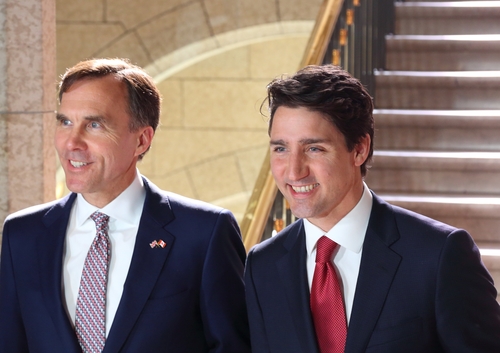 For two years, the federal government and regulators have been talking up the virtues of their mortgage stress test. So, imagine the surprise today when the Prime Minister asked the Minister of Finance to:
For two years, the federal government and regulators have been talking up the virtues of their mortgage stress test. So, imagine the surprise today when the Prime Minister asked the Minister of Finance to:
“Review and consider recommendations from financial agencies related to making the borrower stress test more dynamic.”
The request came in a mandate letter sent by Trudeau’s office. (Multiple ministers got their own letters.)
Canada’s top mortgage trade association wasted no time in applauding the news.
The first burning question
Everyone who saw this is now wondering, does Trudeau’s order pertain to the insured stress test (implemented by the Finance Department), the uninsured stress test (implemented by OSFI) or both.
OSFI’s stress test has taken the most flak, but it’s controlled by our “mostly” independent bank regulator, not the Finance Minister directly.
That said, the Finance Minister has pulled rank on OSFI before (Morneau overruling OSFI in 2017, for OSFI’s controversial restrictions of the word “bank,” comes to mind).
An OSFI official told us, “It is our long-standing practice to consult extensively on all new or revised OSFI guidance; this includes consulting all of the federal agencies which participate in the Financial Institutions Supervisory Committee. That said, OSFI is solely responsible and accountable for the content of OSFI guidance and the supervision of the financial institutions’ adherence to that guidance.”
The second big question
Just as important is the question, what do the words “more dynamic” mean?
It might mean reviewing a change in the calculation of the stress test’s minimum qualifying rate (a.k.a., “mortgage qualifying rate”).
 The MQR only applies to federally regulated uninsured mortgages and mortgages that are default insured.
The MQR only applies to federally regulated uninsured mortgages and mortgages that are default insured.
The MQR is equal to:
- The greater of the mortgage contract rate or the benchmark 5-year posted rate — for insured mortgages
- The greater of the mortgage contract rate plus 200 basis points or the benchmark 5-year posted rate — for uninsured mortgages
Many in the housing industry have advocated for a smaller stress test increment than 200 bps for uninsured mortgages.
Critics of that suggestion, like CMHC CEO Evan Siddall, warn that an easier stress test would fuel higher home prices and more debt accumulation. And that may be true if federal/provincial/municipal governments keep failing to incentivize more building.
One answer to that would be varying the stress test by region. But that would get into complex local rules, which come with their own set of problems. If you have a harder stress test for Mississauga than Milton, for example, all you’re doing is driving homebuyers from one city to another.
The Stress Test Increment
The biggest problem with the stress test is that it relies on a number that can be manipulated, the benchmark 5-year posted rate.
 Banks can manipulate it by keeping 5-year posted rates inflated to earn more mortgage penalty revenue. And bureaucrats—under the delusion they can time the market—can manipulate it by persuading banks (behind the scenes or with public moral suasion) to keep their rates propped up.
Banks can manipulate it by keeping 5-year posted rates inflated to earn more mortgage penalty revenue. And bureaucrats—under the delusion they can time the market—can manipulate it by persuading banks (behind the scenes or with public moral suasion) to keep their rates propped up.
Given how vital housing is to Canada’s economy, we need a stress test that adjusts to the market, acting as an economic shock absorber, of sorts.
One way the government could do that is by basing the MQR on an objective number, like Canada’s 5-year bond yield plus 300 bps, for example.
Were that the case this past summer, the MQR would have been in the 4.30%-range instead of over 5%, where it’s been stuck for almost two years. A slightly easier stress test could have padded home sales and economic activity at a time when Canada’s outlook was deteriorating and everyone was talking about recession risk.
Another Flaw Needing Attention
The Prime Minister might also be referring to correcting flaws in who the stress test applies to.
Regulators absolutely dropped the ball by not exempting people who merely switch lenders from the stress test.
As a result, the stress test has trapped an estimated 5-10% of borrowers with their existing lender, blocking them from switching companies to get better mortgage terms. That’s despite these borrowers adding no more risk to the system by merely changing their lender.
Lenders love captive borrowers. Why? Because they can charge more. “…On renewals, we can get up to 50 bps higher in terms of rate,” said one lender CEO last month.
Affected borrowers should be up in arms that policy-makers are effectively forcing them to pay more. Likewise, those impacted by the economic drag of those borrowers consuming less and defaulting more (because of their higher interest burden) should be equally angered.

 log in
log in
 The Prime Minister might also be referring to correcting flaws in who the stress test applies to.
The Prime Minister might also be referring to correcting flaws in who the stress test applies to.
9 Comments
> And that may be true if federal/provincial/municipal governments keep failing to incentivize more building.
Well actually that’s true regardless of what happens with supply. More easier credit means higher prices.
As for the tweaks, the relaxation of rules on renewal lender switches is a no-brainer.
I bet you’re right that the tweak to the qualifying rate is next most likely. That would make it more “dynamic”.
Hey Leo, More supply could cancel out some or all of the medium-term inflationary impact of an easier stress test.
Maybe “dynamic” means the stress test would apply differently based on your credit score or down payment or something?
yet OSFI has said, based on cold hard facts, that same lender renewal rates were NOT demonstrating this type of captive borrower power (renewal and switch rates were very similar). they also said publicly that they are watching this issue very closely (given all the assertions of negative impacts). so until you, spy, are willing to publish hard data (maybe based on your own business and rates on same lender renewals vs switches) or come up with cold hard facts (and not generalized water cooler jiberjabber) these types of general comments about borrowers having to pay much higher rates due to stress tests falls into the category of fake news – PROVE IT! the only public evidence so far suggests there is no basis for your statements, which seem to be supported only by some anonymous lender CEO who knows a guy. Are we asking too much for evidence rather than anecdotal commentary, especially from brokers who should know factually when and by how much more a borrower is paying: is it 5bps, 10 bps, facts pleeeeeease. you are also guessing what portion of borrowers it actually affects, which just leads me to further conclude this is a red herring until somebody proves there is a problem. a portion of bank clients will stay with the bank at renewal and pay some higher bps with or without a stress test – its has been that way for many years long before stress tests – that’s consumer behaviour, not regulatory policy based. not trying to be too critical – love to read your opinions – but just pushing for a more evidenced based assertion, thanks.
Quite a 180 by the Liberals on this issue. I fear they are just paying lip service to the matter, however, to temper industry criticism.
With supply and demand issues still not being resolved it really makes no difference if they choose to make it easier to borrow. All that will happen is more people will chase fewer properties. Build more high density close to existing transport routes and let the market free to do its thing. Government picking winners and losers always leads to corruption.
David,
>>> Regarding: “Yet OSFI has said, based on cold hard facts, that same lender renewal rates were NOT demonstrating this type of captive borrower power (renewal and switch rates were very similar).”
OSFI’s cold hard facts were anything but. Read our prior comments on OSFI’s October 2018 claim that “there has been no material change in the difference between the rates that renewal customers pay and those offered to new customers.” This data was absolutely inconclusive. Among other things, according to OSFI’s disclosures to us, it:
* Based its sample on a 24-month period that included the pre-B-20 period. (The B-20 renewal effect would have only began after January 1, 2018, and the effect would have likely been more pronounced as time went on–as lenders implemented practices to “risk-price” this new captive audience. Hence, the sample was poorly selected.)
* Lumped all borrowers together instead of measuring renewal offers made to those most likely to be affected (people with high GDS/TDS ratios)
* Failed to account for overall discounting levels in the market at the time of its sample (an increase in renewal discounting for the ~9 in 10 unaffected renewers could have easily masked discount deterioration for the affected group)
If you weren’t aware of these data flaws, you should be as a critic.
>>> Regarding: “They also said publicly that they are watching this issue very closely (given all the assertions of negative impacts).”
How can they watch it closely if, according to their written statements to us, they don’t have all the required data??
>>> Regarding: “Until you, spy, are willing to publish hard data (maybe based on your own business and rates on same lender renewals vs switches) or come up with cold hard facts (and not generalized water cooler jiberjabber) these types of general comments about borrowers having to pay much higher rates due to stress tests falls into the category of fake news…”
If you think for a second that OSFI would share its supervisory data and regulatory returns collected from federally regulated institutions with the public, you don’t know OSFI. This is the *only* direct data that could reliably establish the extent of the problem and they won’t (can’t) share it. And the numbers they do have are incomplete (e.g., according to OSFI, they don’t collect underwriting data on renewers).
As a result, advocates for a stress test exemption use common sense. The circumstantial evidence is clear. Post B-20, retention rates surged, approval rates fell and lenders reported improved renewal revenue. Couple that with common industry knowledge that renewal rates are higher than origination rates at non-transparent lenders, and you don’t need much deductive logic to conclude that more renewers are paying higher rates than they need to. P.S. That CEO wasn’t anonymous. Click the link we provided for the transcript.
The takeaway: Before you rip others based on someone else’s data, you might want to make sure you understand the data you’re hanging your hat on.
what is not so fair about zoning? according to your opinion, should people always be buying in popular spot and neglect all other areas? We are living in a complex world, so complex rule should apply. Your posting and Evan are claiming that concentrating people into single spot is better policy. Categorically, this should be ruled out. Evenly distributed population in such a large country like Canada makes better fiscal and resource sense. Hong Kong must be your ideal world. I beg to differ.
I don’t know what Ian’s comment has to do with the stress test but I’ll comment anyway. He seems to be obtuse to the purpose for densification.
From the Smarter Growth Initiative:
“Densification is a healthy way to manage a city’s growth. A compact, efficient city can make the most of its infrastructure and support a wider range of housing choices. Businesses benefit when a diverse, multi-generational population lives nearby, and having amenities close to home helps us lead healthier lives. Such communities can reduce our dependence on automobiles by building in bike lanes, pedestrian-only streets and easy access to rapid transit. These multi-modal transport design elements also help to manage traffic congestion and reduce parking issues.”